Underground Rome attractions: all you need to know about Rome below street level and how to visit Rome’s most significant underground sites.
Rome is an open air museum; however, it is also a fantastic underground museum, full of hidden attractions buried like treasure under street level!
Under Rome’s beautiful piazzas, statues and landmarks, under the cover of the famous cobbles streets of Rome, many attraction lay, hidden from sight.
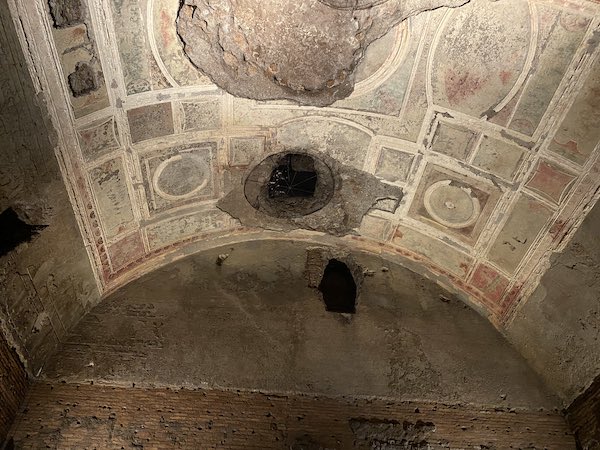
Underground Rome is fascinating, surprising and a fantastic place to learn about Rome.
Many of Rome’s underground attractions are now open to visitors.
However, due to their nature, visits to these sites are usually by guided tour only and require booking.
In this Rome travel guide, I talk about the best underground sites in Rome and what you need to know to plan your visit.
Please note: this post contains affiliate links and, should you make a purchase through them, we might make a small commission.
Rome underground: why are Roman ruins buried?
When taking about Rome underground attractions, we need to first distinguish between subterranean structures that were always meant to be underground and those that did not.
Ancient underground sites in Rome include the catacombs, the Vatican necropolis and several mithraea, ancient temples devoted to the son God Mythra (see below).
Each of these location was under street level by design, the reason for their below-surface nature usually being religious: burial ground or underground shrine of specific Roman Gods are the most common.
Other sites ended up underground due to the twists and turns of history.
Excellent examples of it are Nero’s Domus Aurea, once a lavish and airy palace, the Crypta Balbi or the private houses of Palazzo Valentini or the Caelian Hill.
These now-underground attractions are often awe-inspiring and have the most incredible stories to tell.
Today, I talk about those I believe you will enjoy the most and I recommend visiting.
Rome underground sites worth seeing: chart
| Name of underground structure | Type | Originally subterranean | Address |
| Rome Catacombs | Subterranean tunnels, burial grounds | Yes | Several Locations |
| Vatican Necropolis | Subterranean cemetery, tomb of St Peter | Yes | St Peter Basilica, Vatican City |
| Rome’s Mithraea | Underground temples to the God Mithra | Yes | Several Locations |
| The Capuchins’ Chapel | Underground burial cryp decorated with bones | Yes | Via Vittorio Veneto, 27, 00187 Rome |
| Domus Aurea | Underground palace of Emperor Nero | No | Via della Domus Aurea, 1, 00184 Rome |
| Roman Houses of Palazzo Valentini | Ancient private homes | No | Foro Traiano, 85, 00186 Rome |
| Roman Houses at Caelian Hill | Ancient private homes | No | Clivo di Scauro, 00184 Rom |
| Crypta Balbi | No | Via delle Botteghe Oscure, 31 00186, Rome |
The best underground attractions in Rome
Rome catacombs
The catacombs are probably the best known example of an underground structure in Rome.
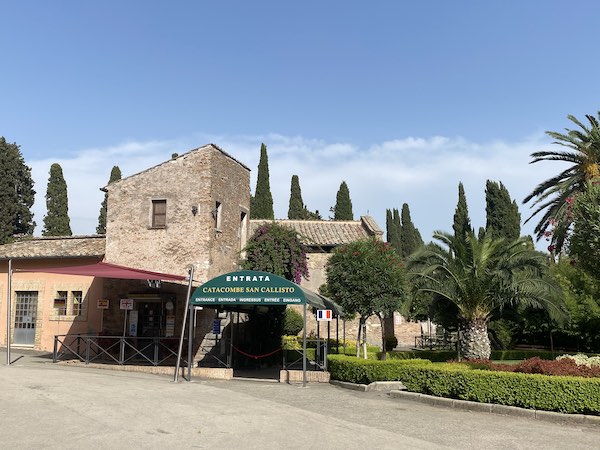
Roman catacombs are a system of underground tunnels spreading over over 20km under street level.
The catacombs are early Christian cemeteries.
Archaeologist dates the most ancient as from the I century AD, but their use became more and more popular as Christianity grew, especially before it became the official religion of the Roman Empire under Emperor Constantine.
As ancient burial grounds, the catacombs are underground by design.
Diggers would start a new catacombs in areas outside the city by digging one layer of graves below grown, and would keep digging as the number of bodied in need of Christian burial grew.
Due to this origin, the catacombs of Rome are different from other subterranean structures: while in standard stratigraphy the lower level is the most ancient, in this case, the most ancient strata are the ones at the top!
The catacombs grew in depth and extension as Christianity spread in the empire: some of the catacombs got to be four storey deep and ended up counting well over half a million Christians!
The catacombs are open to visitors but access is strictly regulated and by guided tour only.

The best catacombs to visit in Rome are:
Catacombe di San Callisto / St Callixtus’ Catacombs: the largest network of catacombs in Rome, the catacombs of San Callisto were the official cemetery of the Church of Rome in the III century AD.
Located along Via Appia, their spread over 90 acres, they are on four levels, all underground, and they reach a depth of 20 meters. The tunnels are 12 mile long and host over half a million Christians, including martyrs and 16 popes,
The most significant crypts here are the Crypt of the Pope, called ‘Little Vatican’ and the Cryps of Santa Cecilia, which not hosts a beautiful sculpture of the martyr.
Address: Via Appia Antica, 110
You can get tickets for the official tour of the Catacombs of St Callixtus here.
Other catacombs worst visiting:
- Catacombe di San Sebastiano: similar to those of San Callisto and in the same part of Rome, they are a smaller site famous for beautiful frescoes. Address: Via Appia Antica,136 Find info and tickets here
- Catacombe di Santa Domitilla: developing over four levels and 15km, these catacombs are most famous for being the resting place of Saints Nereus and Achilleus, martyrs und Diocletian. Address: Via delle Sette Chiese, 282
- Catacombe di Santa Agnese: located under the the Basilica of Santa Agnese Fuori Le Mura, these catacombs are devoted to St Agnes. They have priceless frescoes and are in the same complex as the Church of Santa Agnese and the Basilica of Santa Costanza, an excellent example of round church in Rome. Address: Via Nomentana, 349, 00162 Rome. Guided tours are available here (website in Italian only, tours in Italian and Engish)
- Catacombe di Priscilla: these catacombs stand out for the incredible frescoes they preserve and a first ever recorded image of the Virgin, dating from the II or possibly even the I century AD. Address: Via Salaria, 430- 00199 Rome. Booking info here.
The Vatican Necropolis
The Vatican necropolis is the ancient Christian burial ground of St Peter, who died martyr in Rome in the I century AD.
The necropolis is under St Peter’s Basilica, purposely built on this ground sacred to the Christians, and it is open to visitors in small groups only, due to the fragility and importance of the site.
You can book your tour by contacting Vatican’s Ufficio Scavi here.
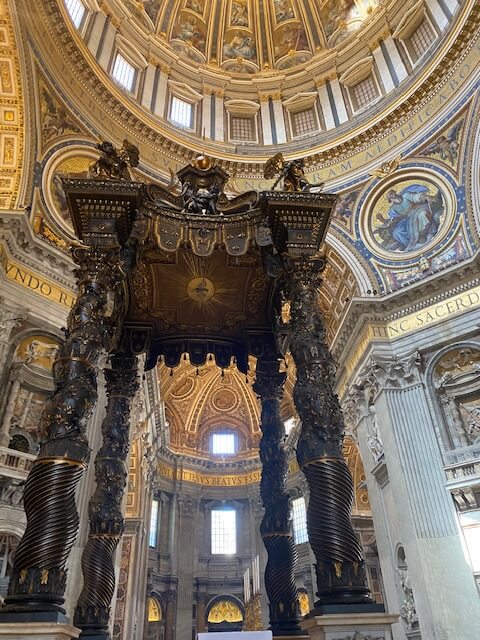
Rome Mithraea
Mithraea is the name of the underground chambers devoted to celebrating the God Mithra.
Mithra is a deity originally from the Near East and became widely worshipped in Rome form the I century, when he became one of the most popular Roman Gods especially among soldiers.
Mithra was a solar and agricultural god and he was worshipped in underground chambers with the celebration of a banquet.
The chambers were called Mithraea and they were subterranean spaces with decorative frescoes and an altar.
The altars were usually carved with an image of the God, represented as a young man killing a bull from whose blood a crop sprouts.
The tauromachia was a common theme in ancient times which represented the victory of order over chaos and all things feral.
There are several Mithraea in Rome but only some of them are open to the public.
The two I recommend visiting are:
- Mitreo Barberini: opened to the public again in 2021, this Mithraeum lies under Palazzo Barberini and is significant for the beautiful frescoes it preserved. The mithreum is the only one in Italy with frescoes and it is therefore unique. Visits are on selected days only: read our complete guide to the Barberini Mithraeum here.
- Mitreo di San Clemente: This Mithraeum is under the church of San Clemente, a unique church in Rome developing over three levels, each latin to a different era. The Mithraeum is its most ancient layer and has a breathtaking altar to Mithra with an impressive carving of the God. The whole of the basilica is worth visiting for its mithreum, its stunning mosaics and the peculiarity of its stratigraphy. You can find info and tickets here.
The Capuchin Crypt
The Crypt of the Capuchins is one of the most peculiar underground attractions in Rome.
Located inside the Church of he Capuchin Friars on Via Veneto, the crypt hosts the remains of the friars and is unique as it is decorated with human bones!
Skulls and bones create archways and designs on the walls of the crypts: while examples of this type of crypt exist in other parts of the world, this is unique in Rome and, even just as a curiosity, it is well worth a visit.
You can find info and tickets to the crypt and museum here.
The Domus Aurea
The Domus Aurea is the palatial residence of Emperor Nero.
Built in the I century AD, the palace was massive and elaborate.
Perched on top of the Oppian Hill, the part of the Esquiline Hill now in front of the Colosseum, the palace was an extravaganza of halls, corridors, chambers and gardens and ancient sources described it as full of natural light.
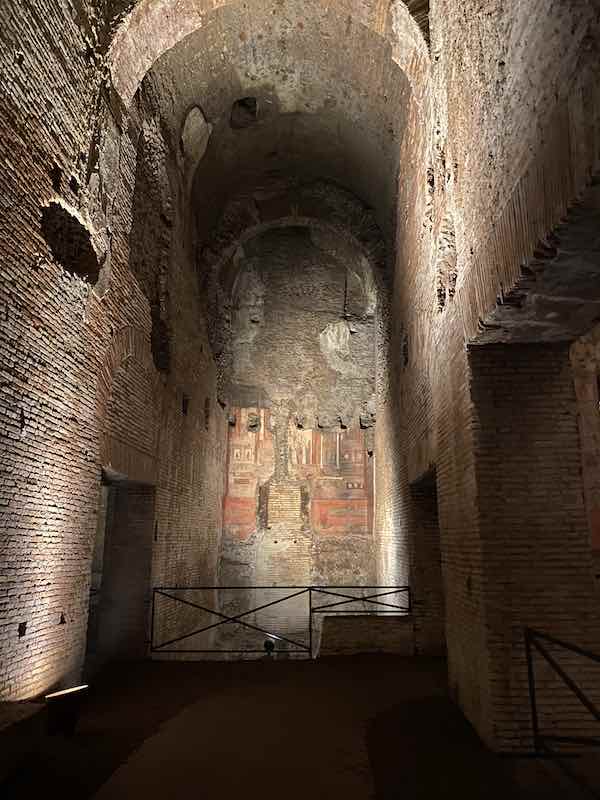
Nero wanted his home to be the most beautiful and lavish Rome had ever seen and never intended for it to become subterranean.
History, however, had other plans!
After Nero’s death, the memory was damned and all that had to do with it got slowly but surely destroyed.
First, part of his house was demolished to make space for the Colosseum.
Later the whole remaining read got filled with debris and became the foundation of a new structure, the baths of Trajan.
These events mean that the entire Domus are now is below street level.
The rooms that once opened over expansive gardens now receive no natural light and the palatial corridors feel like giant underground tunnels.
Despite the terrible fate of this structure the Domus Aurea is wonderful to visit. A light show allows the visitor to appreciate what the palace would have been like and several of hte bautiful decorations o this home are sill visible.
You can read here>>> how to visit the Domus Aurea.
Underground Roman houses
Some Roman houses originally belonging to whey Roman houses are now underground and open to visitors.
Rome private homes came in two main types: the insula and the Domus.
An insula was similar to what we would now call a condo or an apartment block and were accommodation for the poor.
An excellent example of an insula is beside the Capitoline Hill: while not fully underground, it is possible to see its lowest floor, well below what is the street level now.
The insula is only occasionally open to the public; however, you can see it from the road, as you walk beside the Vittoriano from Piazza Venezia towards Piazza del Campidoglio.
A domus, on the other hand, was a single family home and it usually developed around a central yard and with several halls for different uses and family needs.
Roman Domus were at street level and ended up being underground due to the changes in the level of the city.
You can visit Roman Domus in two locations:
Domus Romane at Palazzo Valentini: under Palazzo Valentini, in Piazza Venezia, lies a beautiful example of an ancient Roman house.

Accessible by a large staircase, the domus has been equipped with plexiglass floors that allow you to see its foundations and with a light show that recreates, virtually, how the house would have looked like when in use.
The house is large and the tour well organized.
From it, you also get a close-up view of Trajan’s Column too: an informative video about it is included int entourage of the house.
You can book your tickets here.
Domus Romane del Celio: located on the Caelian Hill, in front of the Palatine, these Roman houses stand out because of the wonderful state of conservation of the frescoed room, which makes them unique in Rome.

The house is below the basilica of Saints John and Paul, who lived here, and have an interesting story: over the course of the centuries, this spaces hosted a domus, then an insula with shops and then a domus again!
Therefore, they are a fantastic place to learn about both these ancient Roman structures.
You can find our review, photos and tips for visiting here
Crytpa Balbi
Crypta Balbi is a fascinating underground attraction in Rome City center now part of the Museo Nazionale Romano (National Museum of Rome).
The crypta develops over several levels and archaeologists consider it one of hte best places in Rome to learn how the city developed over time.
The space originally comprised of an ancient theather, a colonnade (now referred as ‘the crypt’) and an exedra, still visible. This space however, over time, changed use and became a burial ground, a quarry, a bath house and a convent.
This is one of the most significant underground monuments in Rome. You can find info and tickets here.
More underground attractions in Rome you may like
Rome has several underground attractions that are be worth a visit.
Some you may want to consider are:
Colosseum Underground Level: this is not a standalone attraction but rather, the lower level of the Colosseum, where animals and props were kept.
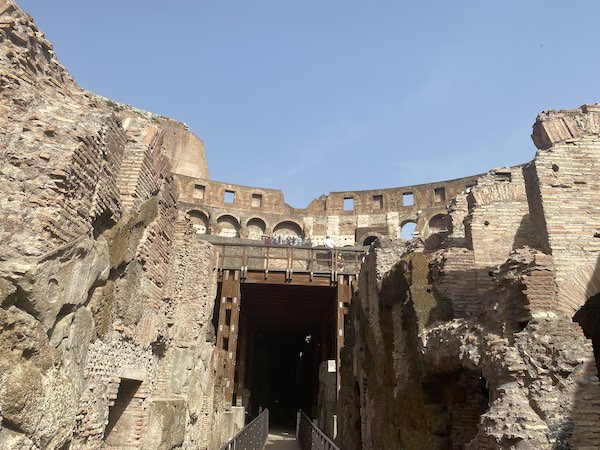
A visit to this part of the Colosseum is well worth the extra cost: the tour allows to understand the inner workings of the Colosseum and looking up, you get spectacular views of the arena and the seating area!
While below street level, at present the lower part of the Colosseum is oper air.
Acquedotto Vergine At Rinascente: this is maybe the most peculiar of all subterranean Rome attractions and you find it inside a shopping mall!
La Rinascente is a swanky department store but, on its lower level, hosts a secret: the ruins of the ancient Virgo Aqueduct, the one bringing water to some of the most famous fountains in Rome, including teh Trevi Fountain (nearby).
You cannot visit the acqueduct as such, but you can admire its arches from the shop floor for free: well worth a stop!
Trevi Underground experience: hidden under the famous Trevi Fountain lies a large archaeological area only partially accessible to visitors. The site is known as ‘Vicus Caprarius’ and has remains of an ancient Roman house destroyed during the fire of Rome under Emperor Nero, and a water cistern feeding the Viro Aquaduct .
Only a small part of this area is open to the public but it can be worth a stop if you ate in the area.
You can find info and tickets here.
Piazza Navona Underground: below Piazza Navona is possible to see what remains of the stadium of Emperor Domitian, now Piazza Navona itself (find here >>> the history of Piazza Navona).
The remains are limited in size but interesting to visi Domitian’s Stadium is hte most ancient Roman stadium in Rome built in masonry. You can book your tour here.
I hope you enjoyed this quick overview of the best underground sites in Rome and it helped you decide which ones to add to your Rome itinerary Safe travel planning!
